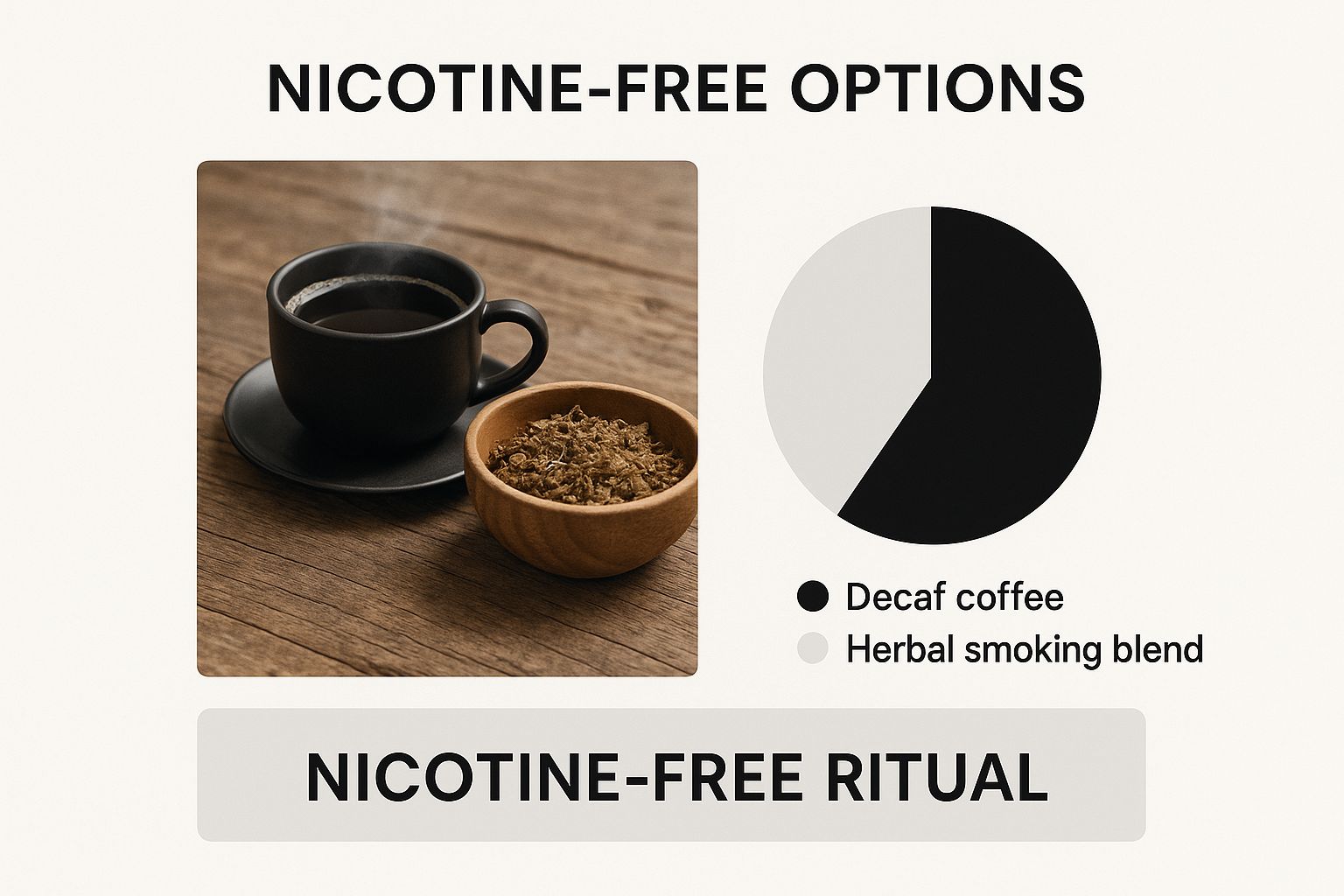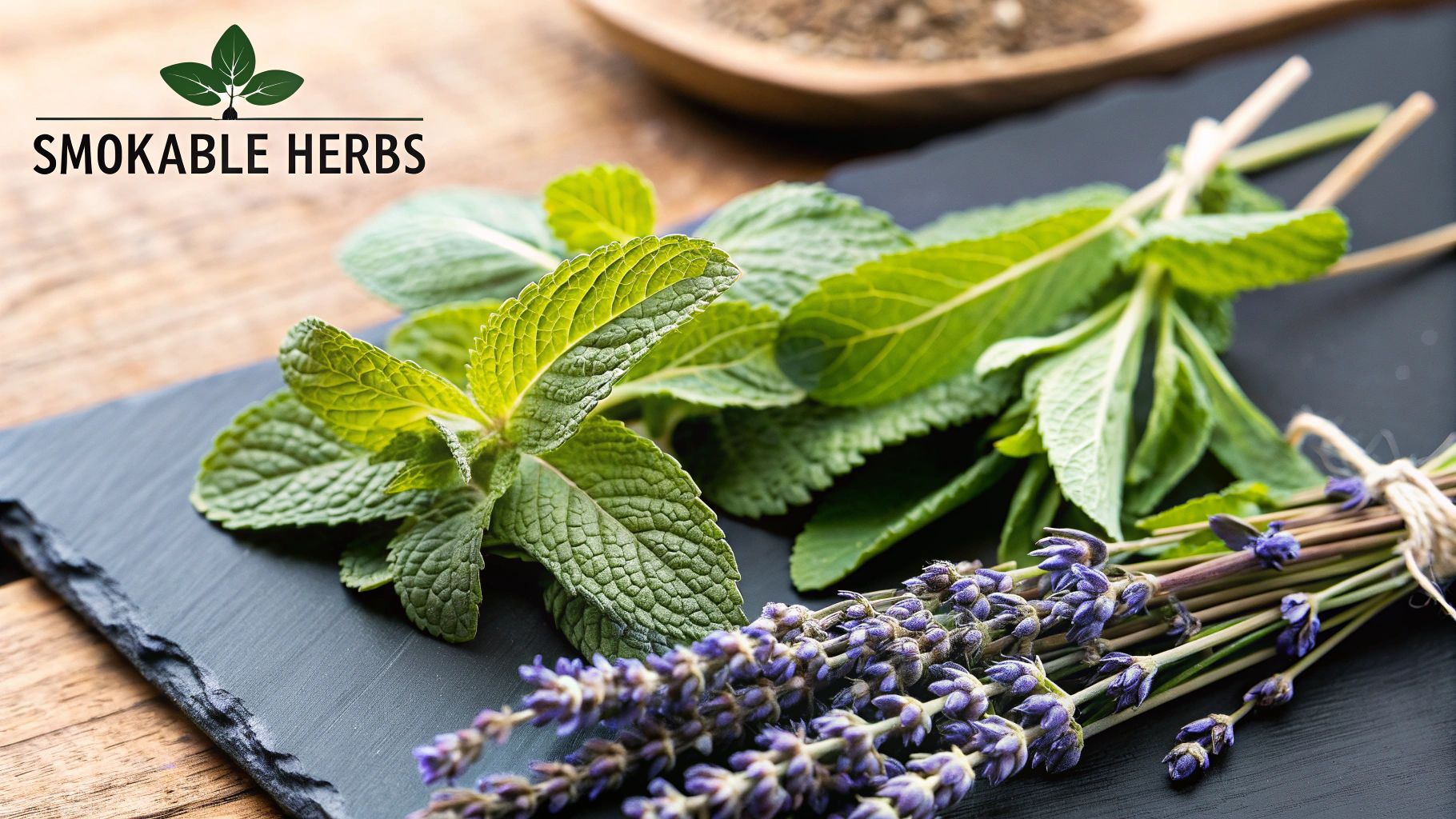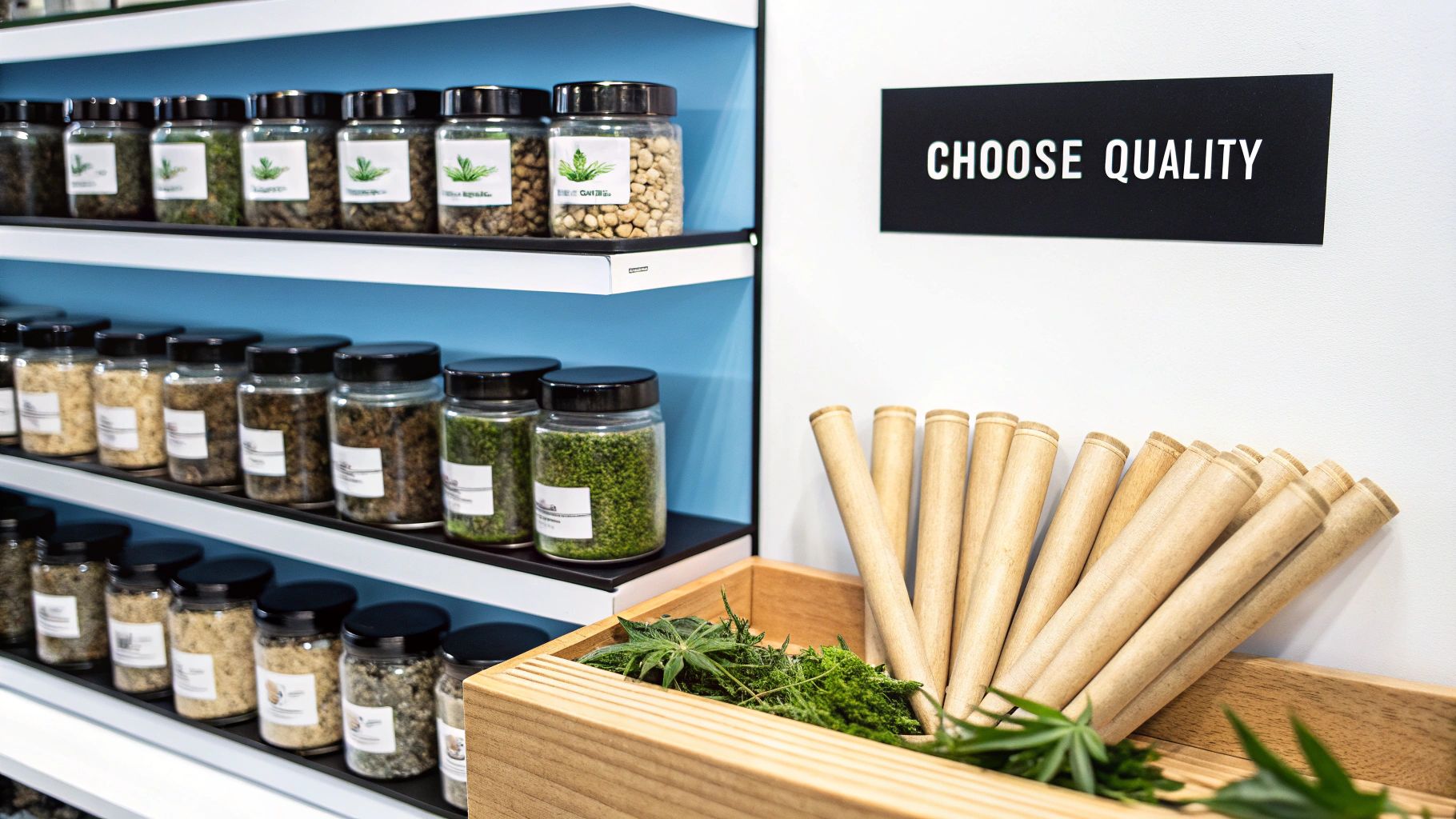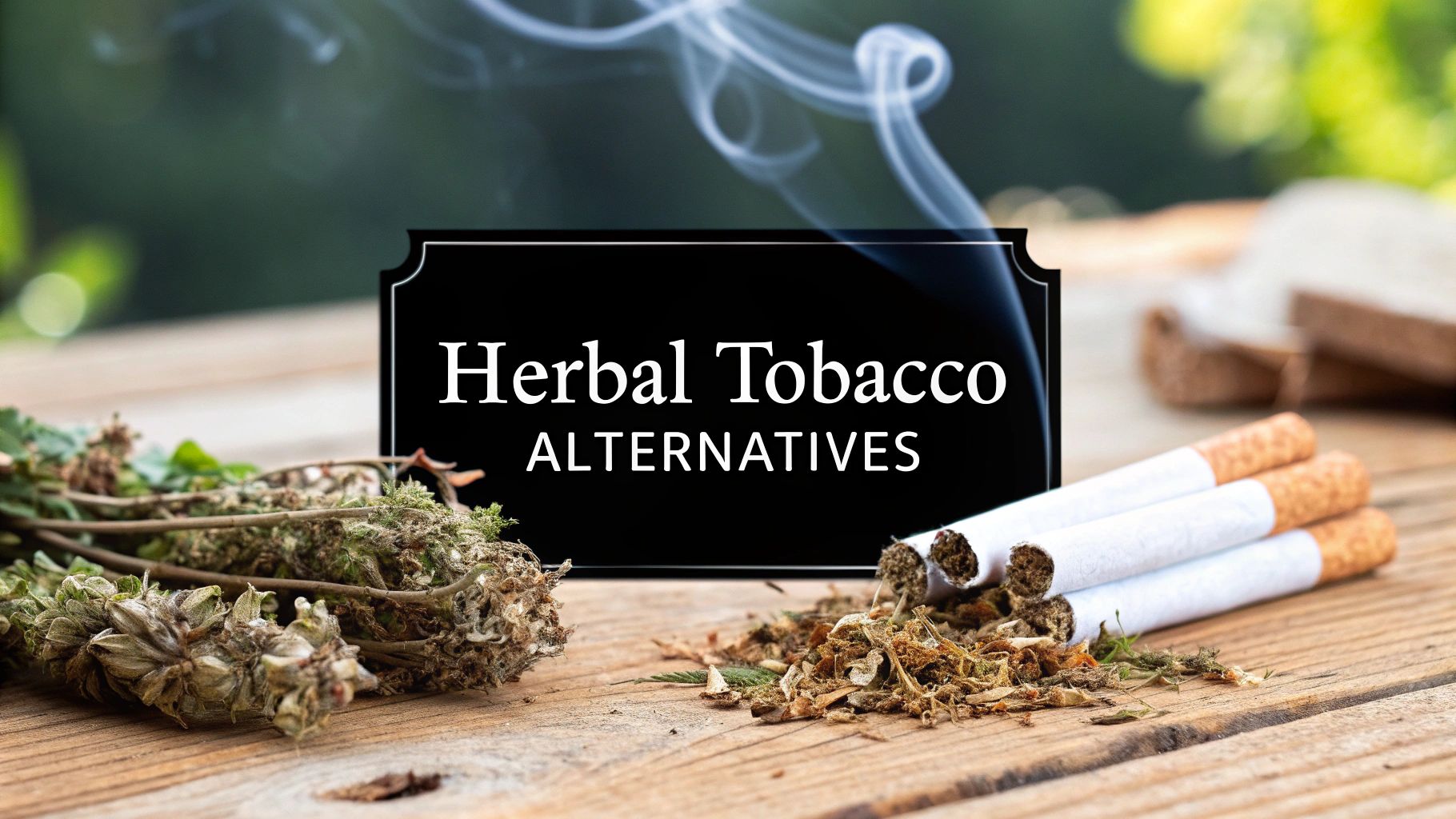Herbal tobacco alternatives are, at their core, nicotine-free blends of smokable herbs, flowers, and leaves. They’re designed to do one thing really well: mimic the physical ritual of smoking. This helps people who are trying to cut down on tobacco by satisfying that hand-to-mouth habit, but without the addictive chemical that keeps them coming back.
So, What Exactly Are These Nicotine-Free Herbal Blends?
Think of herbal alternatives like decaf coffee. You still get the comforting ritual of a warm cup, the familiar taste, and the social aspect of a coffee break, but without the caffeine jolt. In the same way, these herbal blends offer the physical act of smoking without the addictive hook of nicotine. They're made for people looking to break their chemical dependence on tobacco while still finding a way to manage the powerful psychological and habitual side of smoking.
Quitting isn't just a chemical battle; it's also about unravelling a deeply ingrained routine. By swapping tobacco for a non-addictive herbal blend, you can start to separate the physical habit from the chemical craving, which for many is a huge first step.
The infographic below puts it perfectly, framing these blends as a tool for a 'nicotine-free ritual'.

As the visual shows, the real value is in keeping the familiar action while ditching the addictive substance. It’s that separation that can make all the difference on the journey to quitting for good.
Key Differences From Other Products
It's easy to get these products confused with other options out there, so it's important to draw a clear line. Here in the UK, their popularity is growing, driven by a greater focus on health and tougher rules on traditional tobacco. It’s not just a local trend, either. The global market for herbal cigarettes was valued at USD 2.1 billion and is expected to keep growing. You can dig deeper into the numbers in this herbal cigarette market research report.
To really understand where these alternatives fit in, it helps to see them side-by-side with tobacco and vapes.
Comparing Smoking Options: A Quick Guide
Here’s a simple table to break down the key differences between the main options people consider.
| Feature | Traditional Tobacco | E-Cigarettes (Vapes) | Herbal Alternatives |
|---|---|---|---|
| Primary Purpose | Deliver nicotine | Deliver nicotine (often as a harm-reduction tool) | Mimic the smoking ritual without nicotine |
| Key Ingredient | Tobacco leaves containing nicotine | E-liquid, usually containing nicotine, flavourings, and VG/PG | A blend of various smokable herbs (e.g., mullein, raspberry leaf) |
| Addictiveness | Highly addictive due to nicotine | Highly addictive due to nicotine | Non-addictive (nicotine-free) |
| Health Risks | Combustion releases tar, carcinogens, and carbon monoxide | Inhalation of heated aerosols; long-term effects are debated | Inhaling any smoke carries risks, but no tobacco-related toxins |
This comparison makes it clear: herbal blends are playing a completely different game.
Herbal blends focus entirely on the behavioural side of smoking. Their purpose isn't to deliver nicotine more safely, but to provide a nicotine-free tool that helps a person manage the ritualistic urges associated with smoking during their quitting journey.
This fundamental difference in purpose is what really sets them apart from almost every other smoking or vaping product you can find today.
Understanding Common Smokable Herbs

To really get to grips with herbal tobacco alternatives, you have to look past the label and understand what’s actually inside. These blends aren’t just a random handful of dried plants; they’re more like a chef’s recipe, where every ingredient is chosen for a specific purpose.
Each herb plays a part, contributing to the blend's flavour, its aroma, and even the way it burns. Thinking about it this way helps you make smarter choices. Instead of just grabbing any packet, you can start to figure out why a certain blend might give you the smooth, calming experience you’re looking for.
The Building Blocks of a Blend
Most herbal blends are built around three types of herbs, each with its own job to do. Once you understand these roles, you can see how different herbal tobacco alternatives are thoughtfully put together.
-
Base Herbs: These are the foundation. Their main job is to create a light, fluffy texture that burns slowly and evenly. Think of them as the canvas. Mullein is a classic choice, known for being gentle on the lungs while still producing a full-bodied smoke. Raspberry leaf is another favourite, prized for its neutral taste.
-
Supporting Herbs: This is where the character and function come in. These herbs are added for their specific properties, whether that’s to help you relax or feel a bit more focused. You might find lavender included for its calming floral scent or damiana for its subtle mood-lifting qualities.
-
Accent Herbs: These are all about the flavour and aroma. Just a tiny pinch can completely transform the experience. Peppermint or spearmint, for example, can add a cool, refreshing kick, while delicate rose petals bring a soft, sweet fragrance.
The real art of a good herbal blend is in the balance. A skilled creator makes sure no single herb overpowers the others, crafting a harmonious mix where every ingredient works together for a pleasant, well-rounded smoke.
Popular Smokable Herbs and Their Properties
Many of the herbs used in modern blends have been part of traditional wellness practices for centuries. Knowing a few of the common ones can help you pick a blend that suits your personal taste.
The table below breaks down some popular choices you're likely to come across, giving you a better idea of what to expect in terms of flavour and effect.
| Herb | Common Flavour Profile | Primary Characteristic in Blend |
|---|---|---|
| Mullein | Light, mild, slightly sweet | Smooth, full-bodied base |
| Raspberry Leaf | Neutral, earthy, similar to black tea | Fluffy, even-burning base |
| Damiana | Aromatic, slightly spicy, a hint of mint | Mood-enhancing, relaxing support |
| Lavender | Floral, fragrant, sweet | Calming aroma, flavour accent |
| Chamomile | Sweet, apple-like, gentle | Relaxing and soothing support |
| Peppermint | Cool, sharp, refreshing | Strong flavour and aroma accent |
| Rose Petals | Sweet, floral, fragrant | Aromatic, adds a smooth flavour note |
| Marshmallow Leaf | Mild, sweet, slightly earthy | Soothing, helps soften the smoke |
This is just a starting point, of course. From the calming touch of chamomile to the smooth burn of red clover, each herb brings something unique to the table. The more you know about the ingredients, the easier it becomes to find a blend that’s just right for you.
Weighing the Benefits and Health Risks
When you're looking at herbal tobacco alternatives, it’s important to see the full picture. Their biggest advantage is what they don’t have: nicotine. By cutting out this incredibly addictive chemical, they give you a way to tackle the psychological side of quitting smoking head-on.
So many people find that it's the simple hand-to-mouth action and the ritual of deep breathing that are the hardest habits to let go of. Herbal blends let you keep that ritual going, giving you a physical stand-in that can quiet those cravings without feeding the chemical addiction. This clever separation of habit from substance is a massive help for anyone serious about quitting.
The Inescapable Reality of Smoke
But let's be crystal clear about the risks. While these blends are free from tobacco and nicotine, they are not harmless. The simple act of combustion—setting fire to any plant material—creates toxins.
No matter what you’re burning, inhaling smoke is damaging to your lungs. Combustion releases tar and carbon monoxide, and those are present whether you're smoking tobacco or a gentle blend of lavender and mullein.
This means that while herbal cigarettes get rid of the nicotine addiction problem, they still pose a threat to your respiratory health. It’s better to think of them as harm reduction, not harm elimination. They can be a temporary bridge away from a much more dangerous product, but the healthiest end goal is always to stop inhaling any kind of smoke. Understanding the full spectrum of health risks of smoking cigarettes really helps to put this into perspective.
A Tool for Transition, Not a Health Product
Ultimately, you should see herbal tobacco alternatives as a temporary tool to help you transition, not a long-term wellness product. Their real value is in helping you get through those tough early stages of quitting by dealing with the behavioural triggers tied to your addiction.
Here’s a quick rundown of what you need to keep in mind:
- Primary Benefit: They are 100% nicotine-free, which is key to breaking the cycle of chemical dependency.
- Psychological Support: They satisfy that familiar hand-to-mouth habit, making it much easier to manage the ritualistic side of your cravings.
- Inherent Risk: All smoke contains tar and carbon monoxide, which are harmful to your lungs. Period.
- Best Use Case: Use them as a short-term aid to move away from tobacco, not as a permanent substitute.
By weighing up these points, you can make a smart, informed decision about whether this path is the right one for your journey to becoming completely smoke-free.
How to Choose a Safe and High-Quality Blend
 Diving into the world of herbal tobacco alternatives can feel a bit like exploring a new country. It’s exciting, but you want to make sure you're making safe choices along the way. The golden rule is simple: treat these blends just like you would any food or drink. Quality is everything.
Diving into the world of herbal tobacco alternatives can feel a bit like exploring a new country. It’s exciting, but you want to make sure you're making safe choices along the way. The golden rule is simple: treat these blends just like you would any food or drink. Quality is everything.
Always start with the source. You want to see brands that are open and honest about where their herbs come from. Look for blends made with organic, food-grade herbs – this is your best guarantee that they’re free from nasty pesticides or chemicals you definitely don't want to be inhaling.
Your number one priority should always be purity. A truly great blend is beautifully simple: just herbs, and maybe some natural flavourings like fruit extracts. If you see a long list of additives or chemical-sounding names you can't pronounce, it's a huge red flag. Just walk away.
Committing to clean ingredients is the single most important step you can take for a better, safer experience. It’s about being conscious of what you’re putting into your body.
Read the Ingredient List Carefully
Never, ever buy a blend without knowing exactly what’s inside. Think of the ingredient list as your personal guide – it tells you if a product is going to get you closer to your wellness goals.
Are you after the calming, gentle effects of something like lavender? Or do you need a smooth, satisfying base like marshmallow leaf? Understanding what's in the mix helps you know what to expect in terms of flavour and feeling. It's also crucial for spotting anything you might be allergic to.
Quitting is a journey that tackles both the physical and the psychological, and making an informed choice about your alternative is a powerful part of that process. If you want to dive deeper, you can read more about the secret challenge of quitting smoking no one talks about and understand just how much the ritual itself matters.
Practical Steps for Choosing Your Blend
To make sure you're picking a blend you can feel good about, just follow these simple guidelines:
- Check the Sourcing: Go for brands that are transparent about their organic and sustainable farming practices. If they're proud of it, they'll tell you.
- Look for Purity: Make sure the blend is free from synthetic additives, preservatives, or artificial flavours. Simpler is almost always better.
- Start Small: Before you buy a big bag, get a small sample or a trial size. This is a great way to test for any personal sensitivities without a big commitment.
- Pick Your Format: Think about what fits your life. Do you want the convenience of pre-rolled herbal cigarettes, or the flexibility of a loose-leaf blend you can roll yourself?
Finding Your Feet in the UK's Smoking Alternatives Market
Walk into any shop in the UK, and you’ll see shelves dominated by vapes and heated tobacco products. They're everywhere. So, where do herbal tobacco alternatives come into the picture? Well, they've carved out a special little space for themselves, speaking directly to people who want out of the nicotine game entirely—not just a different way to get their fix.
This isn't happening by accident. It's tied to a much bigger shift we’re all seeing towards natural wellness. More and more of us are looking for plant-based options in every part of our lives, from what we eat to the remedies we use. Herbal smoking blends slot perfectly into this mindset, offering an experience that feels more aligned with a natural, holistic lifestyle.
The Growing Hunger for Natural Wellness
This move towards all things natural isn't just a vibe; it's got serious economic muscle behind it. The UK's herbal medicine market, for example, brought in around USD 4.23 billion and is expected to explode to USD 23.6 billion by 2030. That kind of growth shows just how much faith people are putting in plant-based products. You can dive deeper into the numbers on the UK herbal medicine market's growth to see the full story.
This deep-rooted interest in herbal wellness makes it much easier for smokable herbs to find their audience. If you already trust botanicals in your teas, supplements, or remedies, the idea of using them as a smoking alternative just makes sense. It’s an extension of a principle you already believe in: using plants to help you reach your goals.
For a lot of people, choosing herbal blends isn't about chasing the latest gadget. It’s about getting back to something simple and real. It’s a conscious choice to step away from synthetic chemicals and addictive substances, and towards a more mindful, plant-focused way of quitting.
As the rules around tobacco get tighter and the wellness wave continues to grow, herbal tobacco alternatives are stepping out of the shadows. You can now spot them much more easily in health-focused shops and online stores across the UK, standing out as the only truly nicotine-free option for those who are ready to quit for good.
A Few Final Questions
Even after digging into the details, it's completely normal to have a few questions buzzing around. Let's clear up some of the most common ones about herbal tobacco alternatives so you can feel totally confident about your path forward.
Are Herbal Smoking Blends Legal in the UK?
Yes, absolutely. In the UK, herbal smoking blends and herbal cigarettes are completely legal to buy and use, as long as they don't contain any controlled substances like tobacco or cannabis. You'll typically find them sold as incense or herbal products.
This is part of a much bigger shift in consumer habits. People across the United Kingdom are actively moving away from traditional cigarettes. In fact, even the UK heated tobacco market is expected to hit a value of £448 million by 2025. It’s a clear sign that people are looking for options beyond regular combustible tobacco. You can see more on this trend in this UK heated tobacco market snapshot.
Do They Really Help You Quit Smoking?
They can be an incredible ally, but it's important to understand how they help. These blends work on the psychological side of addiction, not the chemical one. Since they are totally nicotine-free, they won’t do anything to stop the physical withdrawal symptoms.
Where they really shine is in helping you break that powerful hand-to-mouth ritual. That physical habit is so deeply ingrained for most smokers. By giving you a non-addictive substitute for the action of smoking, they make the transition away from tobacco feel far less jarring. If you're building a plan to quit, our guide on how to quit smoking naturally might offer some extra support.
What Do Herbal Blends Taste and Smell Like?
This is where the experience is completely different from tobacco, and it all comes down to the specific herbs in your blend. Some might have a light, floral scent from ingredients like rose petals or lavender. Others could offer a cool, refreshing flavour thanks to herbs like mint.
Unlike the harsh, unmistakable smell of burning tobacco, herbal smoke is often much softer and more fragrant. Think more along the lines of incense than a traditional cigarette. Don’t go in expecting a direct replacement for the taste of tobacco; instead, be open to a totally new and different sensory experience.
Are Herbal Tobacco Alternatives Safe to Smoke?
This is the most important question, and it deserves a straight answer. No, inhaling smoke of any kind is not good for your lungs. The act of combustion—whether it's from tobacco or herbs—creates tar, carbon monoxide, and other harmful toxins.
However, when compared directly to traditional cigarettes, herbal tobacco alternatives are widely seen as a form of harm reduction. By ditching the tobacco, you're eliminating nicotine and the thousands of added chemicals found in commercial cigarettes.
The best way to see them is as a temporary tool to help you stop smoking altogether, not as a risk-free, long-term habit. The ultimate goal should always be to become completely smoke-free.
Ready to embrace a nicotine-free ritual that’s both calming and satisfying? AuraFlow offers a simple, natural way to manage cravings without smoke, vapour, or addictive chemicals. Discover our Starter Kit and find your favourite flavour to begin your journey to a smoke-free life. Explore the AuraFlow Starter Kit today
